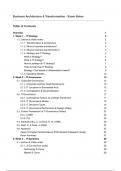Resume
Business Architecture & Transformation BAT(BM03BIM) ( Grade: 8,9/10 ) Summary ALL content covered (lectures, guest lectures, notes)
- Cours
- Établissement
This summary contains everything from the Business Architecture & Transformation (BM03BIM) course from the Master of Business Information Management. This summary has been developed by a group of 7 students, and with mutual efforts, we created this master summary. We combined all our notes from the...
[Montrer plus]



